Also see
The Ranger and Valiant Audio System
When I was first getting into amateur radio in Toledo, around 1960, I mostly listened to 160 meters. I was awestruck at how powerful and clear Ranger and Valiant transmitters sounded.
Johnson Ranger and Valiant transmitters had the best audio on 160 meters. Johnson engineers did a good of sizing components. They obviously intended the audio system to roll off lows and accent highs to give the signal more "punch". Johnson designers did not get carried away with accenting highs as badly as Heathkit did in the Apache, DX-100, and other rigs.
We really don't need to tear-up our classic equipment to get have excellent audio with our Ranger and Valiant transmitters. Provided other components are in good shape, changing value of a few capacitors will do everything necessary. Unlike many other AM rigs, the classic Johnson transmitters had pretty darned good audio systems.
Caution with Those Hammers and Torches!
While I'm sure the intentions are good, there are many modifications that do not actually do what is claimed. Some are not seriously harmful, mostly giving a false sense of "improvement" but causing no real harm. Other mods, unfortunately, tear up or cannibalize an otherwise pretty good piece of classic AM equipment. There are many excellent sounding signals with no more than good microphones and good audio adjustment on stock transmitters. With a few simple mods, the good-sounding transmitters can be optimized for strong signal ragchews.
Some audio system changes remove nearly all upper frequency rolloff. If we want those "ssesses" to stand out in speech, we might want to extend high frequency response a bit beyond the ~4 kHz Johnson used, but we should also remember this does nothing for communications through QRM or noise, especially on crowded bands. Collins, and everyone else in the communications and broadcasting industry, already realized broadcasting extremes of speech frequencies only helped when signal-to-noise ratio was very high. The extra lows and highs sounded great when loud, but seriously reduced communications effectiveness when signals were weak. If we listen to the bassy AM operators when signals are weak, we find they are very difficult to copy when compared to normal communications audio. Collins worked this all out many years ago, settling on an optimum passband for readability. It wasn't 10Hz to 10,000Hz! Over-emphasized bass and treble removes power available for the 300-3300Hz range so important for communications, and taxes the transformers so much that we run a serious risk of damaging expensive transformers. At the very least, excessive lows and highs increase intermodulation and bandwidth, ruining QSO's up or down the band from splatter and irritating other operators, who sometimes make it a point to return the "favor" and retaliate against and disrespect all AM'ers.
There is a second issue sometimes missed in the Johnson audio chain. The later stages of the modulator section show increasing phase shift at very high audio frequencies. When the rolloff is eliminated at frequencies we can't use anyway, and if we add audio feedback, the negative feedback can shift phase and become positive feedback. This can make the audio system unstable. Mods that radically extend lows subject the modulation transformer to high-energy low-frequency bass frequencies (that do nothing to improve readability).
Finally, I don't believe the people who designed your Ranger were so stupid or careless that they made a mess of the total audio system. It would be normal engineering practice to design a good system, and then adjust one component to tailor slope. My bet is they intentionally sized C52 to increase audio punch at the expense of making people sound like Ted Baxter.
The Diode "Super-modulation" Modification
One popular change is the addition of a silicon rectifier diode, or a group of diodes in a fancy circuit, in the modulation transformer secondary. The thought or claim is the diode or diode network limits negative peaks and prevents splatter. It does this by preventing the anode from going below zero volts on negative modulation peaks. This is sideways-thinking for two major reasons:
1.) Going to zero-carrier is actually not what causes splatter or excessive bandwidth. The slope of waveform abruptly changing, going in a new direction towards a straight line, causes the signal to get wide. It's really a "Fourier problem", where the rapid change in slope requires high-order harmonics to produce the waveform.
2.) A plate modulated tetrode tube, contrary to what we might assume from causal understanding of plate modulated stages, reaches zero carrier long before the modulated high voltage reaches zero volts. The diode limiter will limit too late, unless the modulated stage uses a hard class-C low-mu triode in the PA.
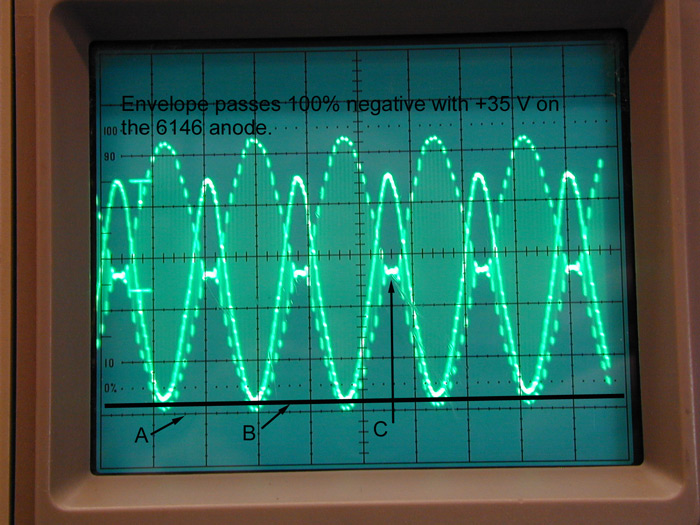
This is the modulated high voltage supplied to a Johnson Ranger II, along with the RF envelope in the second trace.
Line A was set for zero anode voltage
Line B is approximately 40 volts positive for the modulated anode supply voltage (200 volts per division for this channel with zero voltage set at scope graticule A)
Point C shows the RF envelope cutting completely off (over-modulation) even through the modulated high voltage never reaches zero volts.
Peak anode voltage is around 920 volts, operating anode carrier average voltage is 510 volts. This includes modulator secondary voltage drop.
Notice the high voltage does not have to double on positive peaks, and does not go to zero on negative peaks even though the stage is slightly over-modulated. This is because the modulated stage is a tetrode, NOT a triode! The modulated stage has both screen and plate modulation applied, as all tetrodes require. Triodes would require the anode voltage going to zero, and the anode voltage doubling for 100% modulation. See amplitude modulation for an explanation of why this occurs.
The modulation in the Ranger is very linear and has very low distortion with any "negative feedback" or other tricks.
While amateur radio reference materials oftentimes tell us negative anode supply voltage causes splatter, that is a gross oversimplification. In an AM system, the device being modulated actually must behave as a linear response mixer. The audio in effect is the signal, the carrier is the local oscillator. It isn't the fact the PA receives negative voltage that causes splatter or over-modulation, it is the fact the "local oscillator" or mixer is shut off abruptly, with a rapid transition in waveform slope, as the PA reaches zero output. We can "go negative" as much as we like with anode voltage and the energy in splatter does not increase, UNLESS we change the angle of slope abruptly at the zero-crossing transition.
Just like with a CW envelope (CW is really 100% modulated AM), the rate of level change or slope angle at any point in the envelope sets the bandwidth. Moving the diode from inside the tube (the cathode-to-anode path is the diode) to the outside of the tube doesn't modify or correct the slope errors. It does not allow us to reach 100% negative peaks without generating splatter. The carrier still reaches zero-volts with an abrupt waveform slope transition, and splatter is just as bad, whether the diode is inside the PA tube or moved to the outside.
What the authors and proponents of most "diode limiter" super-modulation modifications intend to do is produce a negative peak limiter. They think this allows the modulator to hit the PA stage hard with audio and produce high positive peaks without splatter, but they miss the most important points! Properly designed negative peak "hard-limiters" must always be followed by a suitable low-pass filter. The low-pass filter rounds off transitions, and causes the carrier to gently slope to zero on negative peaks. This gentle slope, caused by the low-pass filter, limits the maximum frequency of distortion products and the transmitter's bandwidth (although it does nothing for in-band distortion). If the low-pass audio filter is omitted, the diode or diodes do nothing to constrain bandwidth. It's a totally useless mod without a low-pass filter!
I actually spent considerable time with my spectrum analyzer (it makes direct measurements of adjacent channel power) and my Viking Valiant, and found no matter what I did with a diode or diodes in the modulation transformer secondary, there was absolutely no reduction in adjacent channel energy for a given level of audio. The diode, no matter how configured, did not make bandwidth better.
What did allow me to run asymmetrical peaks was a simple mod to the 6AL5 clipper in the Valiant. I disabled one section of the dual diode, leaving the clipping effective only on one audio polarity. Since this "hard-limiter" is followed by a good 3.5-4kHz low-pass filter, the transition is rounded and off-frequency energy caused by clipping is attenuated. I could limit negative peaks to 100% in my Valiant and have 120% positive peaks with very little increase in bandwidth, but I had to do the clipping before the low-pass filter.
The Weak Interstage Transformer Myth
Another myth is the audio driver transformer is "weak". No matter what I did with the driver transformer, when the modulator tube control grids were driven positive, the grid voltage of the modulator tubes flattened off and clipped. This is caused by the load on the audio driver stage abruptly going from the nearly open-circuit impedance of the negative-biased modulator tube grids into sudden conduction when the modulator grids swing positive. This causes the modulator grids to draw current, and this suddenly loads the driver transformer with a power consuming load. This problem occurs with the Valiant, but did not appear in my Ranger at 100% modulation. My Ranger easily reached 100% modulation without pushing the modulator tubes into grid current, the modulator tubes remained class AB1 even at 120% modulation.
The grid waveform distortion remained nearly the same in my Valiant regardless of the size of transformer I used. My Valiant had peak distortion or clipping caused by modulator grid current when at 100% modulation, and increasing driver transformer size while maintaining the same impedance ratio did not significantly reduce distortion. Changing the driver transformer impedance ratio did make a difference. A lower primary-to-secondary impedance ratio reduced modulator grid voltage, but at the same time it reduced peak clipping more. Loading the secondary with a resistor had much the same effect. Both of the changes reduced the load impedance variation seen by the driver tube.
The Ranger, fortunately, easily makes 100% modulation before the modulator grids go into conduction. The Valiant modulator system is not capable of producing clean low-distortion class AB2 operation no matter what is done with the existing driver. I changed the audio driver tube in my Valiant to a higher transconductance dual triode, and added negative feedback from one modulator tube anode to the cathode of the 6C4. While the driver system can be rebuilt, there is a simple solution to this problem. Run less power. By reducing plate current to 300 mA, the Valiant modulator does not have to be pushed into class AB2 for 100% modulation. When the modulator is operated AB1, distortion is considerably less.
By the way, using a "transformer-less" driver stage does not make things better. I copied a direct coupled circuit from the web, and my Valiant's distortion actually got a bit worse. As soon as I pushed the 6146 modulator tubes into class AB2, the peaks clipped.
The Audio Choke in the PA Screen Mod
Another modification calls for adding an audio choke in the PA screen grid. The screen requires a moderate percentage of modulated voltage that is in-phase with the anode modulation. This is because a tetrode, even in hard class C operation, is a very poor mixer. The PA tube has a very non-linear transfer function when modulation is applied only to the anode. A tetrode does not follow square-law power response with a variation in anode voltage alone. The tetrode screen grid (or control grid) must also be modulated.
The engineers at Johnson were not as dumb as people might have us believe. The Ranger and Valiant already came very close to optimum screen audio voltage. Johnson did this by obtaining screen voltage from the modulated plate voltage via a dropping resistor.
In some rigs, it is advantageous to adjust screen-to-anode modulation voltage ratios. The circuit below is from my modified Globe Scout 65; it demonstrates how to increase modulation applied to the screen:
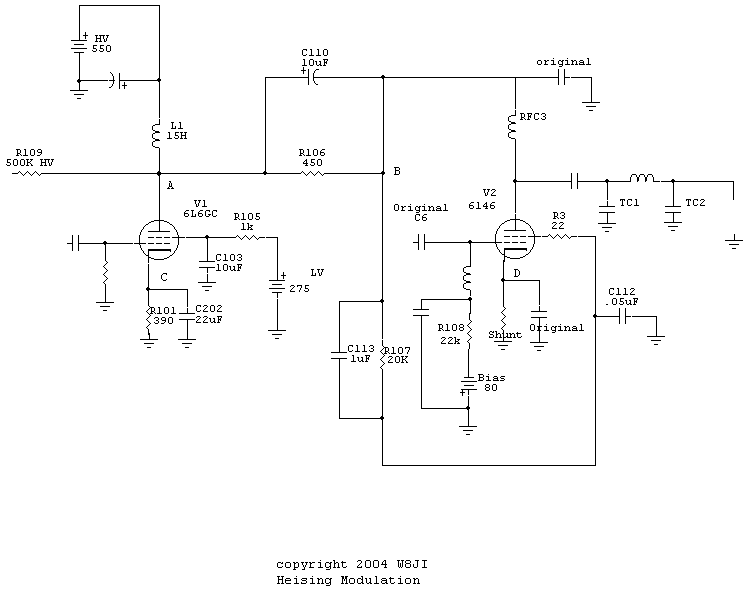
C113 increases audio voltage applied to the screen. In some radios it might be necessary to add a series resistance with C113, but best modulation linearity and lowest distortion occurred in my Globe Scout 65A without a resistor in series with C113. My rig worked best with full modulation swing on the 6146 screen.
In other cases screen resistor R107 may or may not require shunt capacitor C113. If C113 is required to achieve 100% linear modulation, the screen's audio voltage can be limited with an additional resistance (not shown) in series with C113. (Rather than adding a resistance in series with C113, the resistance of R107 could be split between two series resistors. C113 could then only bypass one resistor. R107 could be a tapped adjustable resistor of the proper value to establish proper screen voltage, with C113 between the slider and the end.) Any resistor in series with C113 should be selected for best modulation linearity.
If you want to optimize or play with the screen audio voltage, you can do so by adding a 5 to 20uF, 900 volt (two 450's in series) capacitor from the positive end to the screen end of the screen dropping resistor. By adding a resistance in series with the new capacitor to the modulated HV source, you can increase the amount of screen modulation for maximum peak linearity. If you take the same circuit and shunt the screen to ground though capacitors and resistors, you can decrease the amount of modulation applied to the screen. I found there was very little room for improvement over what Johnson did from the factory when the PA was operated to specification!
Save your money and don't drill up that old rig, the choke isn't needed and actually can be harmful.
Ranger Modifications
The following is an analysis of Ranger modifications found on the Internet:
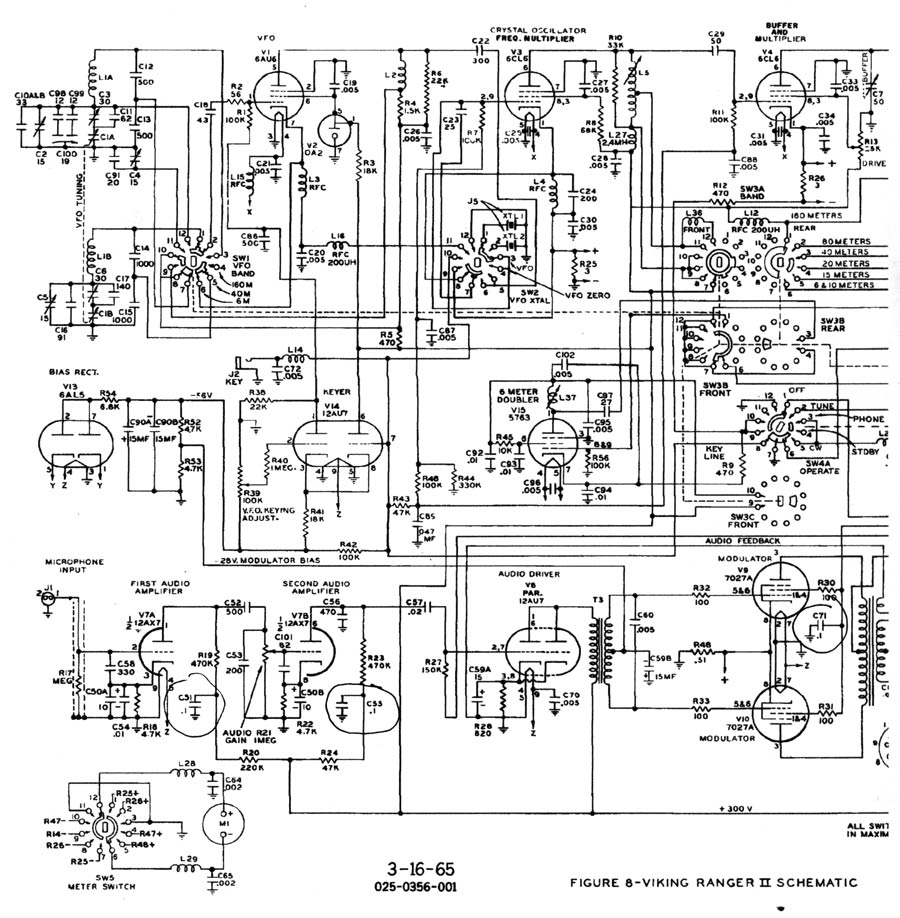
Remove
C-53?
C53 is 200 pF in
parallel with three
resistances. Those
resistances are the
plate resistance of
V7A, R19, and
R23.
200pF @ 3kHz is
265k ohms. That 265k
ohm impedance is in
parallel with about
50k ohms, so
removing C53 would
have a negligible
effect. It doesn't
change anything
measureable. Let it
alone.
Remove C-56?
Again about C56 is
470pF or 113k @
3000Hz in parallel
with the plate
resistance of V7B,
R23, and R27. That's
113k in
parallel with about
45K ohms. Again, not
a big change in
level although very
slightly more effect
than removing C53.
Leave C53 alone, too.
Remove
C-60?
Removing this cap
could destabilize
the audio system! It
is in the negative
feedback loop. The
internal Ranger
audio feedback loop
has negative
feedback around this
component. Removal
of this cap won't
affect response when
feedback phase is
negative!!
Removing this
capacitor impacts
frequency response
and gain on
frequencies where
feedback is
positive, such as
those far above
normal audio
frequency ranges!
Any advice to remove
this part is very
bad advice!!!
Change
C-52 from 500 pfd to
.02 mFd
OK, this is about
the only major
worthwhile effect,
since it
will bring low
frequencies up
several dB. In my
own rigs, I've found
that a change from
500 pF to .01 uFd
was far more than
enough.
Change C-51
and C-55 from .1 to
20 mFd
This is a wasteful
change. This change
won't do anything
except reduce very
low sub-audible bass
slightly. The reason
why is very easy to
see. The impedance
at the point where
C51 and 55 are
attached is very
high compared to the
reactance of the
capacitor. C51
at .1mF is 5.3k ohms
reactance. The
impedance at that
point in the circuit
to the audio path is
470k ohms. Obviously
any change in
voltage across C51
or C55 caused by the
time-varying anode
current of the 12AX7
is so miniscule the
20uF is a wasted
effort. I measured
only a few nanovolts
of AC across C51 at
300Hz.
Change
C-57 from .02 mFd to
.1 mFd
C57 is 26.5K @
300Hz. It's in
series with about
100k ohms total R
(counting feedback).
This reactance
causes about 1.5 dB
rolloff at 300Hz.
Changing C57 to .1uF
will increase lower
end gain, but it
will also unbalance
overall response by
about three dB or so
when low end is
compared to high
end.
The Ranger (and
Valiant) really
don't require a bass
gain increase beyond
increasing C52!
Audio response is
very flat with only
a change in C-52. As
a matter of fact
changing C-57 to a
larger value creates
a problem.
Increasing the value
of C57 causes the
lows to be
emphasized more than
highs, and then this
change forces you to
go back through the
rest of the circuit
to boost highs just
because you
unbalanced the
response!
Change
C-71 from .1
mfd to 20 mfd
I'm not sure of the
effect of this, but
my instincts tell me
it has no effect.
Any effect would
depend heavily on
peak screen
current. In my
Ranger, there was no
measurable effect.
By the way, you can use disc capacitors. It makes absolutely no difference in sound or performance if you use an orange drop or a ceramic disc in audio circuits. Save your money and time, and use whatever is handy to you.
Sine wave response
Left, 250 Hz audio Right, 2500 Hz audio
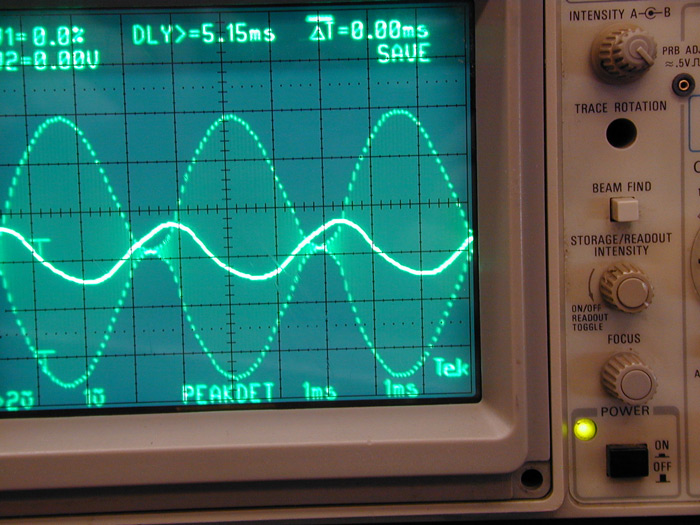
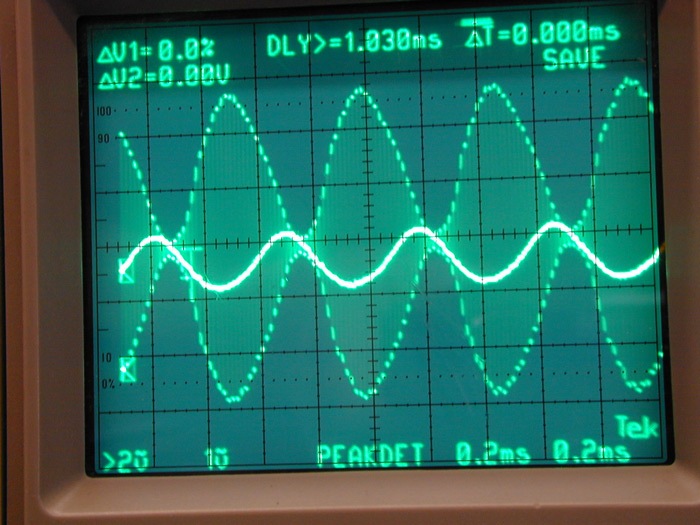
The Ranger has excellent audio with no changes except the value of a few coupling capacitors.
Triangle wave response
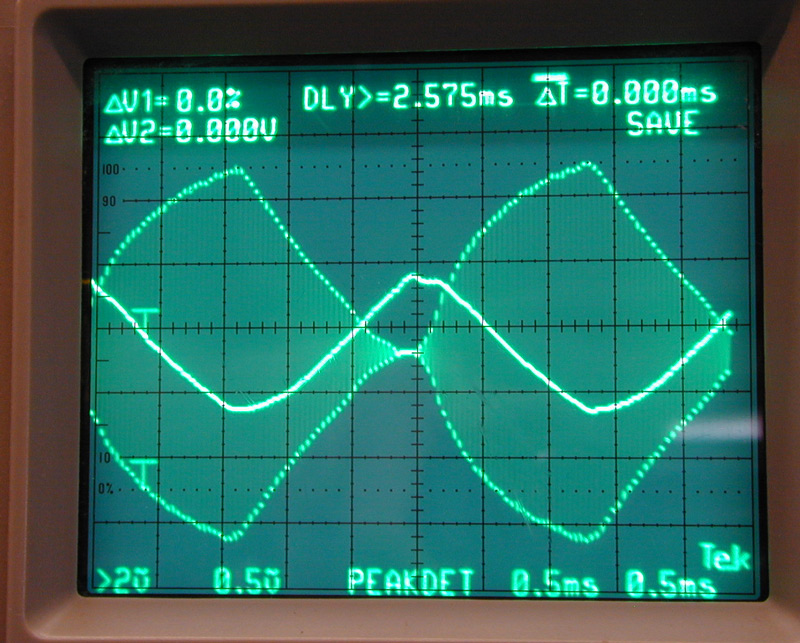
The line trace is the audio at the gain control pot. The envelope is the RF output waveform.
The Ranger closely replicates the waveform applied.
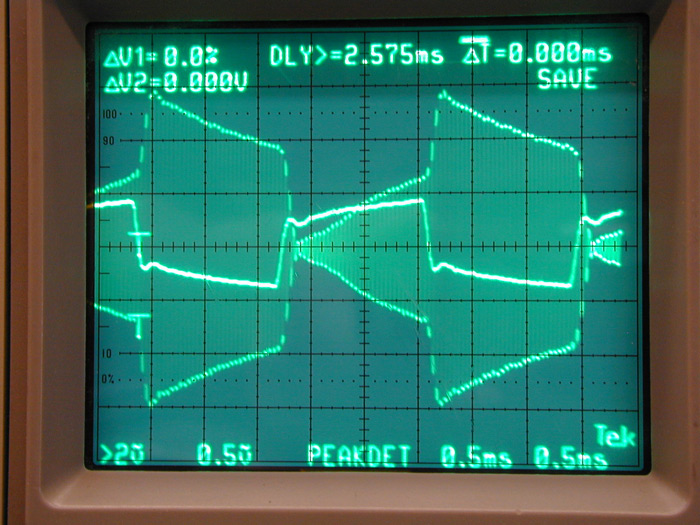
Square wave response is also quite good. The sag of the top is caused by low frequency response starting to roll off below 200 Hz. The slope left or right on the rising and falling edges is caused by the rolling off of high frequency response rolling off above 3500 Hz.
Again the single line trace is the audio at the audio gain pot, R21.
Pictures of my Valiant and its waveshape.
SPICE simulation of a minimal modification improvement to Ranger and Valiant audio
Original response at anode of V7A:
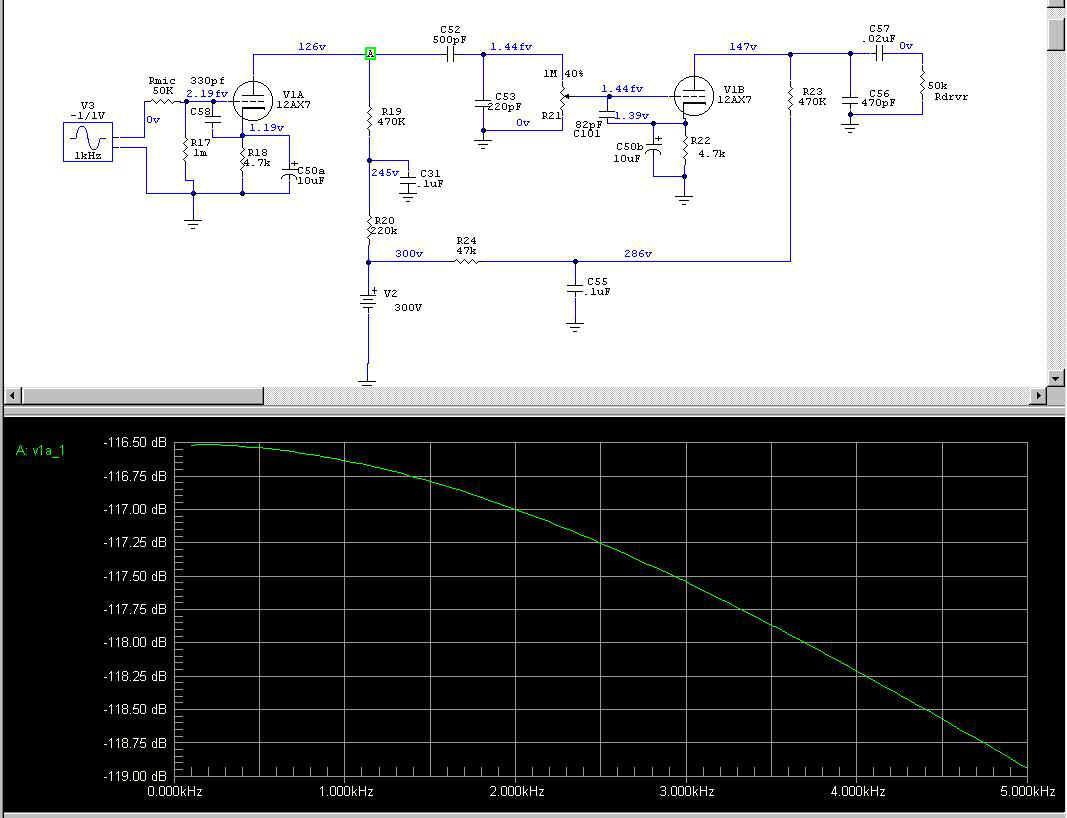
Note the rolloff is only 1dB at 3000 Hz.
C52 produces the following slope:
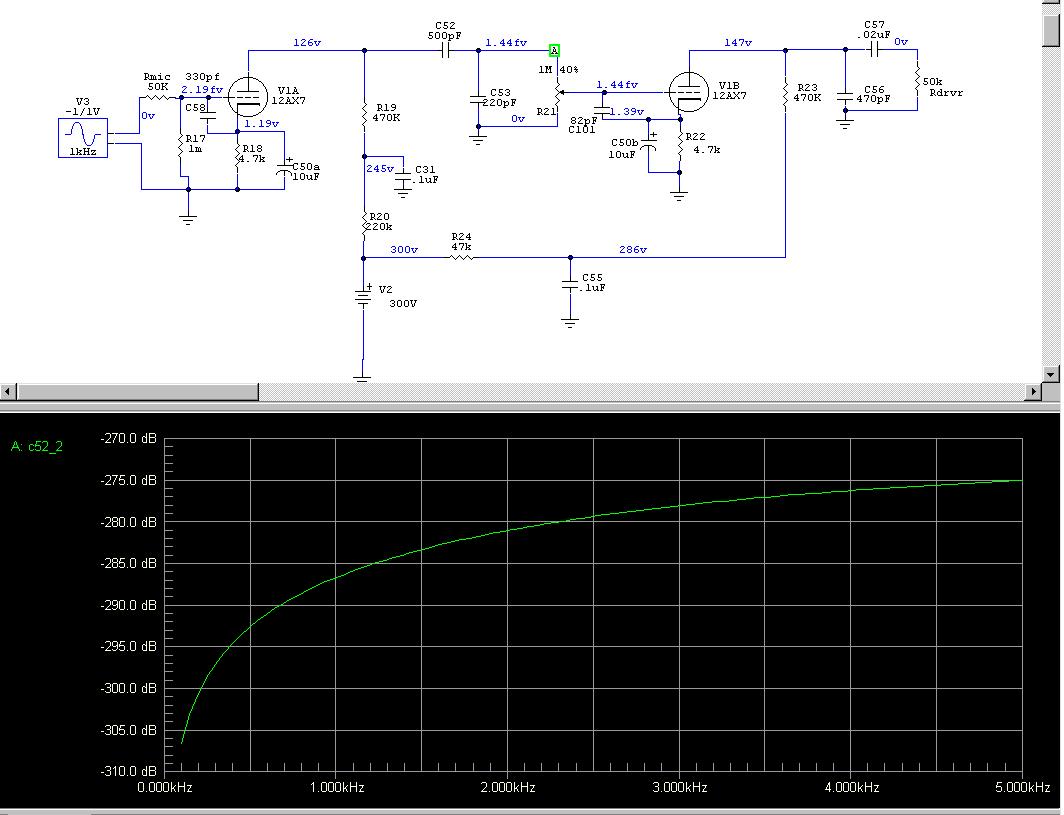
Below is frequency response at anode of V7B.
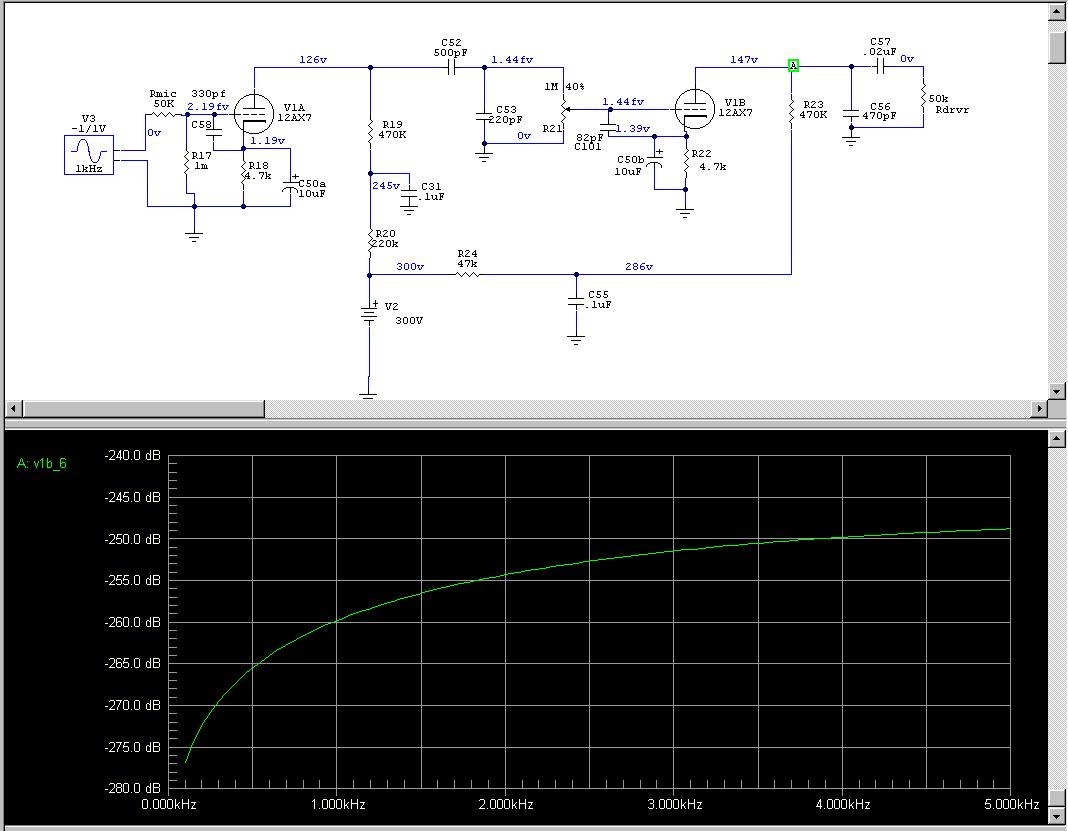
Note the large low-frequency rolloff. Rolloff is from -252dBv to -267dBv or a bass loss of 15dB. This was done intentionally to peak the QRM-and-noise-cutting high frequencies for DX work.
Note how very little C57 affects the audio curve in the sweep below.
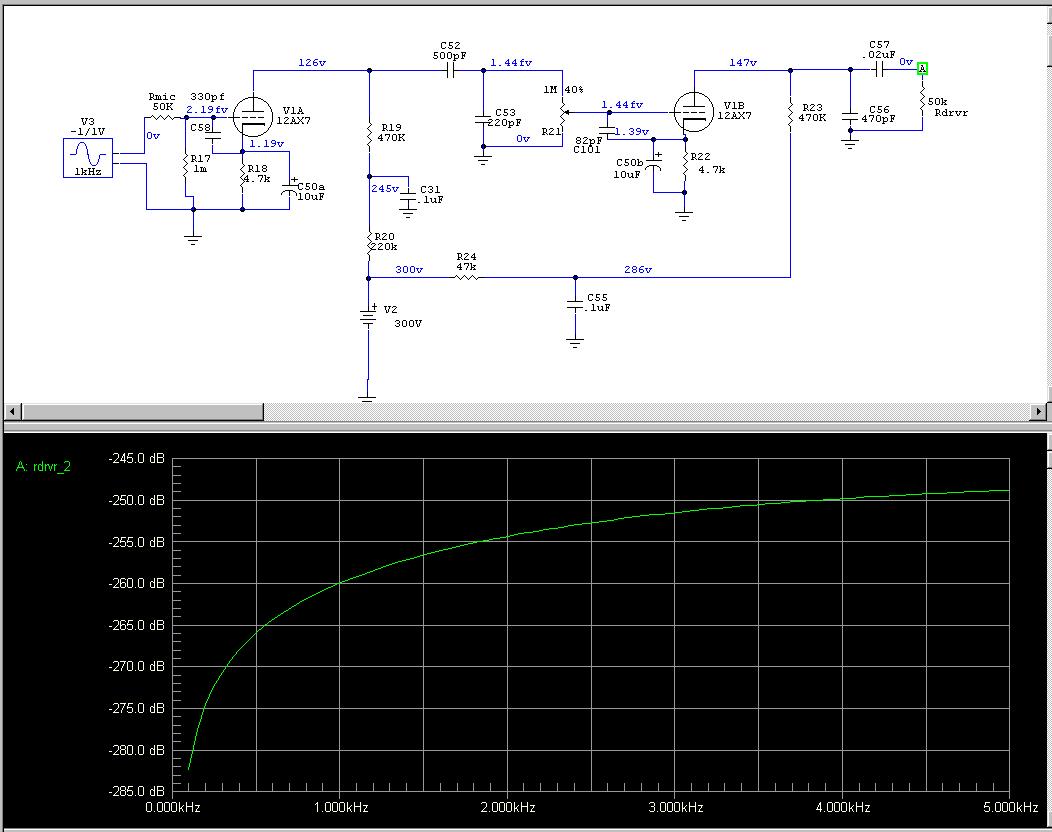
Frequency response slope is almost exactly the same on either side of C57. C57 is large enough.
Changing C52 Only
Overall response when C52 is changed:
*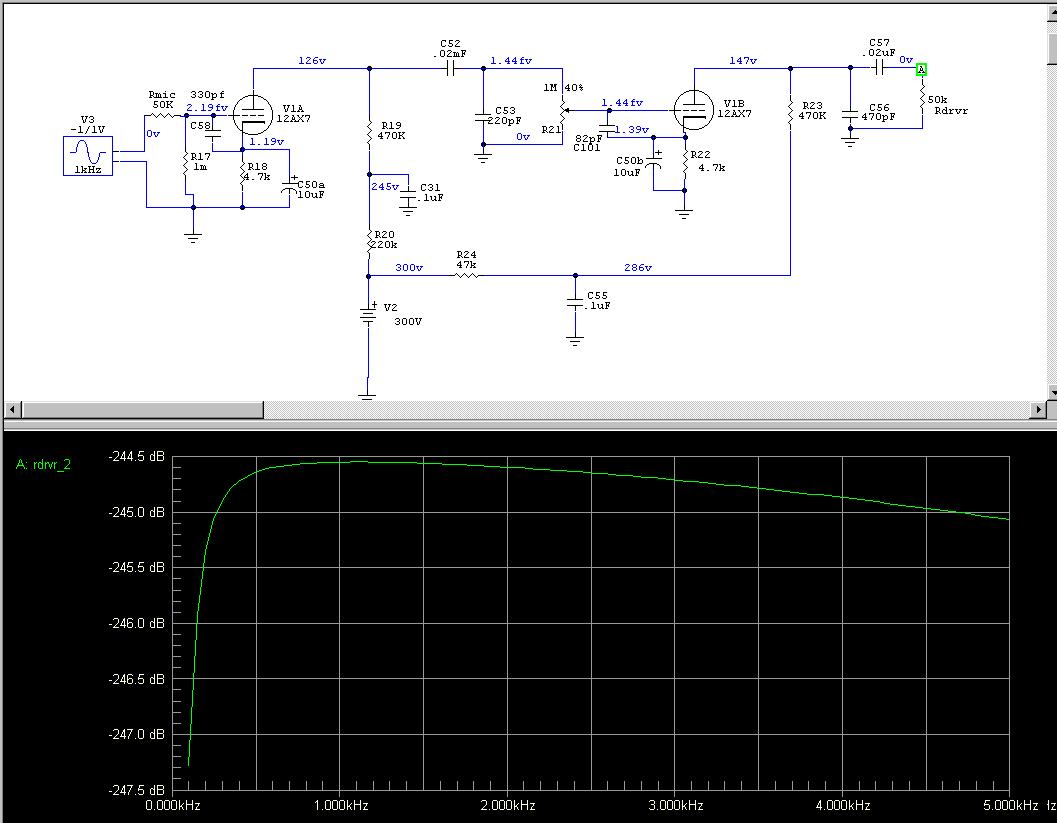
The graph above is 1/2dB per cross line. Overall response actually is quite good when only C52 is changed. Response falls within about 1/2dB from 200Hz to 5000Hz. Expanded view of C52 mod result:
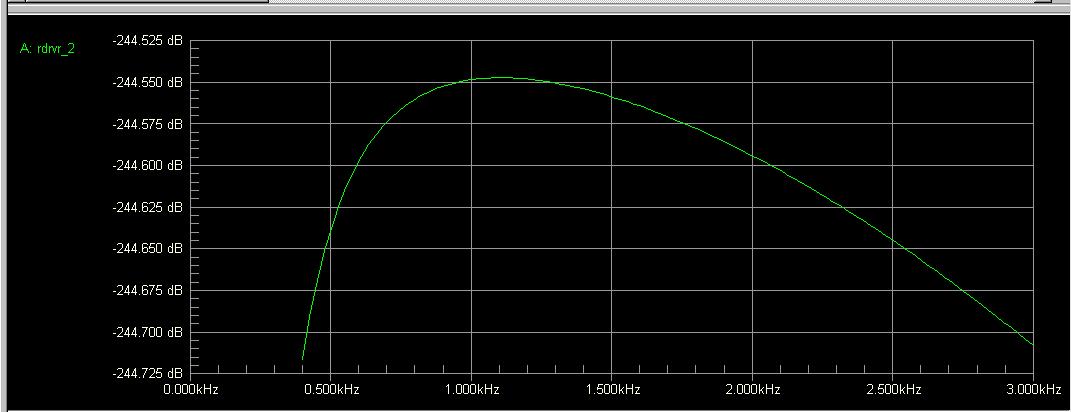
Between 400Hz and 3000Hz there is less than .2dB variation! All this from changing only one capacitor in your Ranger.
-244.720dB @ 400Hz
-244.545dB @ 1150Hz
-244.705dB @ 3000Hz
This will give excellent sounding full audio without excessively taxing audio transformers. At the same time your Ranger is preserved, it isn't all hacked up with dozens of changes that produce insignificant results.
The old timers at Johnson weren't that stupid after all, were they? I'll bet they did the math when they picked parts.
as
of 1800Z on 2005 Dec
26